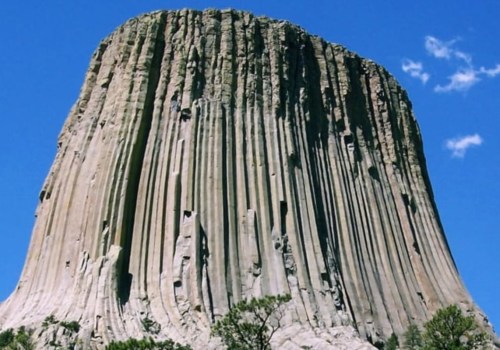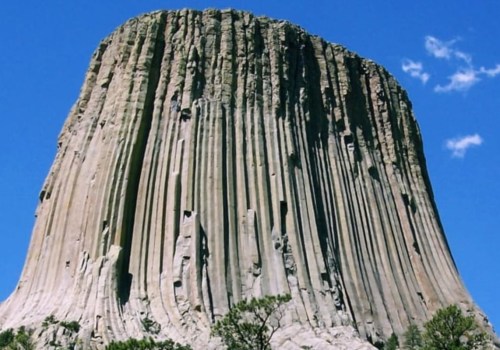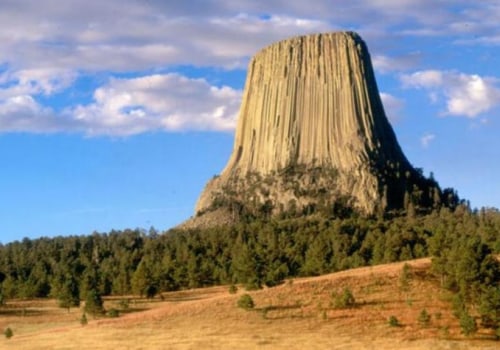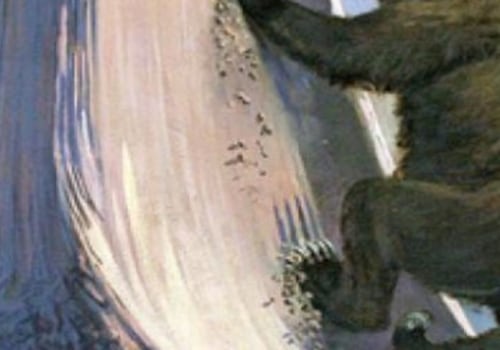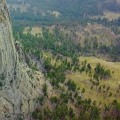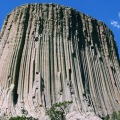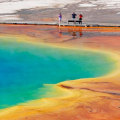Devils Tower in Wyoming is an awe-inspiring natural formation that rises 1,267 feet above the Belle Fourche River, 867 feet from top to base. It is a spectacular sight, with its flat top covering 1.5 acres (0.6 hectares) and its fluted sides measuring 264 meters (867 feet) in height from its base and 386 meters (1,267 feet) measured from the river valley. Its summit has an elevation of 5112 feet (1558 meters) above sea level. The tower is mainly light gray and beige in color, and is covered in lichens, sage, moss and grass.
Squirrels and birds live at the top, and a pine forest covers part of the surrounding country; there is also a sizeable prairie dog village near the base of the tower. Geologists Carpenter and Russell studied the Devil's Tower in the late 19th century and concluded that it was formed by an igneous intrusion. Modern geologists agree that it was formed by the intrusion of igneous material, but not how exactly that process was carried out. Many believe that the molten rock that comprises the Tower may not have surfaced; others are convinced that the tower is all that remains of what was once a large explosive volcano. At the time the Devil's Tower was formed, the surface of the surrounding land was almost 915 m (3,000 feet) higher than it is today. There are two theories about how Devils Tower was formed.
One theory holds that Devils Tower is a laccolito. A laccolite is a large mass of igneous (volcanic) rock that penetrated through sedimentary rock beds, but did not actually reach the surface, producing a rounded bulge in the upper sedimentary layers. The other theory is that Devils Tower is a volcanic plug, or the neck of an extinct volcano. The composition of the volcanic material that forms Devils Tower suggests that the magma body was quite thick when it formed, which allowed it to maintain the shape it currently has. A thinner magma body would form a hard layer over a wider area that resists erosion and remains on a flat plateau.
But because it was relatively thick, the magma became a massive lump, forming its visible shape. The magma then solidified, preserving Devils Tower. The columns of Devils Tower, which rise hundreds of feet in the air and extend up to 10 feet wide, are truly spectacular. Ironically, the erosion exposed by the Tower also erased the evidence needed to determine which theory of its formation is correct. Presumably, if Devils Tower were a volcanic plug, any volcanic created by it volcanic ash, lava flows and volcanic debris would have eroded long ago. The Tower's harder igneous rock is more resistant to erosion, and the gray columns of Devils Tower began to stand out above the surrounding landscape. The columns of Devils Tower are similar to those found in other parts of the world, such as in the Devils Postpile National Monument in California.
On an evolutionary time scale, the rock that forms Devils Tower has a relatively young age of 40 million years. Finally, if erosion continues at its current rate, eventually only a small portion of Devils Tower will remain visible above ground level. As rain and snow continue to erode the sedimentary rocks surrounding the base of the Tower, and as the Belle Fourche River washes away debris from its flanks, more of Devils Tower will be exposed. Geologists agree that Devils Tower began as magma, or molten rock buried beneath Earth's surface. This formation was created when magma (volcanic rock molten inside Earth) was placed in place underground. After it hardened and cooled, erosion occurred over time which exposed this magnificent formation.
